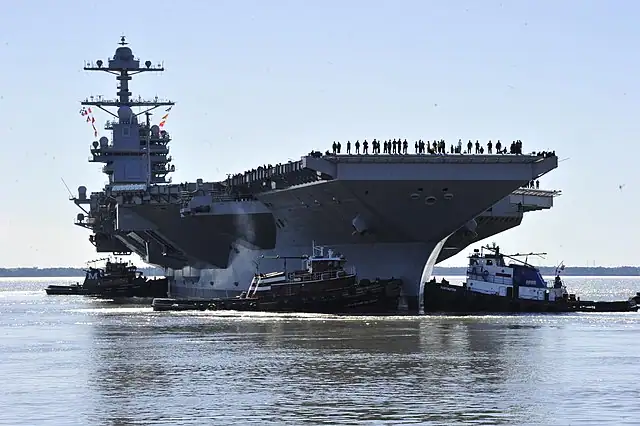Naval warfare has always been a critical aspect of global military strategies, and throughout history, nations have sought to establish dominance through their impressive warships. Today, we take a closer look at the 10 largest warships in the world ( currently in service ), as these behemoths of the seas exemplify the technological prowess and military might of their respective nations. From aircraft carriers to amphibious assault ships, these vessels showcase the sheer magnitude of human engineering. Let’s delve into the world of naval powerhouses.
List of the 10 largest Warships in the World
The 10 largest warships in the world are USS Gerald R. Ford, Nimitz-class, Admiral Kuznetsov, CNS Fujian, HMS Queen Elizabeth, Charles de Gaulle, Izumo-class, Cavour, Juan Carlos I and Dokdo-class.
USS Gerald R. Ford (United States)
The USS Gerald R. Ford, commissioned in 2017, stands as the largest warship in the world. It leads the Ford-class of aircraft carriers, representing a significant leap in naval capabilities and technology. With the first new class introduced in over 40 years, it marks the phased replacement of the Nimitz-class carriers.

The USS Gerald R. Ford houses a vast array of aircraft, including fighter jets, helicopters, and unmanned aerial vehicles (UAVs). The nuclear-powered warship uses an Electromagnetic Aircraft Launching System (EMALS) instead of traditional steam catapults for launching aircraft.
The USS Gerald R. Ford is a true supercarrier because it can hold twice as much fuel for planes and four times as many weapons compared to France’s smaller Charles De Gaulle carrier.
The USS Gerald R. Ford honors the 38th president of the United States, Gerald R. Ford. During the WW-II, Ford was a lieutenant commander in the US Navy.
Key Features
- Type: Aircraft Carrier
- Length: 1092 ft (333m)
- Displacement: About 100,000 tonnes ( full load)
- Speed: 30 knots ( 56km/h)
- Service life: 50 years
- Crew: About 2600
- Aircraft carried: 75+
- Aviation facility: 1,092 ft × 252 ft (333 m × 77 m) flight deck
Nimitz-Class Aircraft Carriers ( United States)
The Nimitz-class aircraft carriers, a cornerstone of the United States Navy, have long been hailed as the epitome of naval power. Named after Admiral Chester W. Nimitz, the renowned World War II Pacific fleet commander, the Nimitz-class aircraft carriers have seen a remarkable lineage since the launch of their lead ship, USS Nimitz, in May 1975. Over the years, a total of ten carriers have been constructed, with the USS George H.W. Bush being the final vessel commissioned in January 2009.
Key Features
- Type: Aircraft Carrier
- Length: 1092 ft (333m)
- Displacement: 100,000-106,300 tonnes ( full load)
- Speed: 30+ knots ( 56km/h)
- Service life: 50 years
- Crew: 5000-5200
- Aircraft carried: 85-90 fixed wings and helicopters
- Aviation facility: 4.5-acre flight deck
Admiral Kuznetsov (Russia)
The flagship of the Russian Navy, the Admiral Kuznetsov, is a unique aircraft carrier. Launched in 1985, this vessel spans over 1000 feet and primarily operates a mix of fighter aircraft and helicopters. Despite undergoing significant modernization efforts, it is due to be replaced by a more advanced carrier in the future.
Key Features
- Type: Aircraft carrier
- Length: 1000 ft 8 inch (305 m)
- Displacement: 58,600 tonnes ( full load)
- Speed: 29 knots ( 54 km/h)
- Crew: around 1600
- Aircraft carried: 24
- Aviation facility: 14,700 square metres
CNS Fujian (China)
CNS Fujian represents a significant milestone in China’s naval modernization efforts. It is the largest aircraft carrier ever built by China. It holds significant importance in the modernization goals of the People’s Liberation Army (PLA) as it works towards commemorating its centenary in 2027. Interestingly, the aircraft carrier is named after the Fujian Province which is just across a narrow strait from Taiwan.
China’s largest warship CNS Fujian was launched on June 17, 2022. It features an indigenous design and incorporates an advanced electromagnetic aircraft launch system, similar to the USS Gerald Ford.
Key Features
- Type: Aircraft Carrier
- Length: 984.3 ft (300.01m)
- Displacement: 80,000 tonnes ( full load)
- Speed: 28+ knots ( 51.9 km/h)
- Crew: around 3000
- Aircraft carried: 35+
- Aviation facility: Flight deck width 76m
HMS Queen Elizabeth (United Kingdom)
As the pride of the Royal Navy, HMS Queen Elizabeth is an aircraft carrier that stretches approximately 932 feet in length. Launched in 2014, this massive ship boasts a displacement of around 70,600 tons and carries an assortment of F-35B Lightning II fighter jets.
Key Features
- Type: Aircraft Supercarrier
- Length: 932 ft (284 m)
- Displacement: 65,000 tonnes
- Speed: 25+ knots ( 46 km/h)
- Crew: around 700
- Aircraft carried: 65+
- Aviation facility: 280m long and 70m width
Charles de Gaulle (France)
The French Navy’s flagship, the Charles de Gaulle, is a nuclear-powered aircraft carrier measuring approximately 858 feet in length. With a displacement of around 42,500 tons, this vessel projects power through its embarked Rafale and Super Étendard fighter jets.
Key Features
- Type: aircraft carrier
- Length: 858 ft (261.5 m)
- Displacement: 42,500 tonnes (full load)
- Speed: 27 knots (50 km/h)
- Crew: around 1,350
- Aircraft carried: 30-40
- Aviation facility: flight deck width 64m
Izumo-class (Japan)
Originally designed as helicopter destroyers, the Izumo-class ships of the Japanese Maritime Self-Defense Force are among the largest warship in the world. Japan is upgrading these destroyers and will transform them into aircraft carriers. With a length of approximately 813 feet and a displacement of around 27,000 tons, these vessels possess both offensive and defensive capabilities.
Key Features
- Type: Destroyer
- Length: 813 ft 8 inch (248 m)
- Displacement: 27,000 tonnes ( full load)
- Speed: 30 knots ( 56 km/h)
- Crew: around 1000
- Aircraft carried: 28 max
- Aviation facility: N/A
Cavour (Italy)
As the flagship of the Italian Navy, the Cavour represents Italy’s commitment to maritime defense. With a length of 850 feet and a displacement of around 35,000 tons, the Cavour is an aircraft carrier that boasts a unique design, combining fixed-wing aircraft capabilities with helicopter operations. It serves as a vital asset for Italy’s maritime security and international deployments.
Key Features
Type: Aircraft Carrier
Length: 800ft 6 inch (244 m)
Displacement: 30,000 metric ton ( full load)
Speed: 29+ knots ( 54 km/h)
Aircraft carried: 20-30
Aviation facility: 763ft 1 inch x113 ft 2 inch flight deck
Juan Carlos I (Spain)
The Juan Carlos I, a multipurpose amphibious assault ship, serves the Spanish Navy with distinction. Stretching approximately 752 feet in length, it offers the flexibility to conduct various missions, including power projection, humanitarian aid, and amphibious operations.
Key Features
Type: Aircraft Carrier
Length: 757 ft 3 inch (230-82 m)
Displacement: 26,000 ton
Speed: 21 knots ( 39 km/h)
Aircraft carried: 30 max
Aviation facility: 202m (663 ft) long flight deck
Dokdo-class (South Korea)
South Korea’s pride, the Dokdo-class amphibious assault ships, are formidable additions to the nation’s naval arsenal. With a length exceeding 653 feet and a displacement of over 19,500 tons, these vessels can accommodate helicopters, armored vehicles, and troops for amphibious operations.
Key Features
- Type: Landing platform helicopter
- Length: 653 ft (199 m)
- Displacement: 19,500 tonnes ( full load)
- Speed: 23 knots (43 km/h)
- Crew: around 350
- Aircraft carried: up to 15 helicopters
- Aviation facility: flight deck with 5 landing spots
Summary of the 10 Largest Warships in the World
The 10 largest warships in the world exemplify the immense power and technological advancements achieved by their respective nations. These floating fortresses not only project military strength but also serve as a symbol of national pride and sovereignty. As naval warfare continues to evolve, these warships play a vital role in shaping global geopolitics and maintaining maritime security.








What about INS Vikrant ???